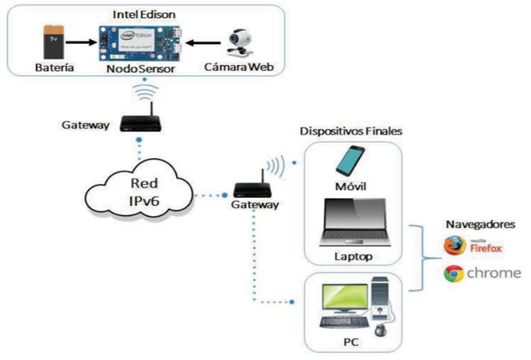Evaluation of the operating time of a wireless node in video transmission over IPv6
Main Article Content
Abstract
Many applications on the Internet of Things require mobile nodes, with mobile connectivity, powered by batteries to transmit video of good quality for long periods. Maximizing the operating time of mobile nodes that work with batteries is a challenge today. We present the evaluation results of the working time of a small-sized wireless node that uses batteries and transmits the video over IPv6 to devices connected to the Internet. The tools used for the implementation, the configuration of the prototype elements, and the descriptions of the different scenarios are presented. The node's current and voltage are measured to calculate the energy consumed and the working time of the node. The estimated value is compared with the operating time measured in a natural environment, validating the simple expressions used to evaluate the active time of a node.
Downloads
Article Details

This work is licensed under a Creative Commons Attribution 4.0 International License.
Authors who publish in this journal agree to the following terms: Authors retain the copyright and guarantee the journal the right to be the first publication of the work, as well as, licensed under a Creative Commons Attribution License that allows others share the work with an acknowledgment of the authorship of the work and the initial publication in this journal. Authors may separately establish additional agreements for the non-exclusive distribution of the version of the work published in the journal (for example, placing it in an institutional repository or publishing it in a book), with acknowledgment of its initial publication in this journal. Authors are allowed and encouraged to disseminate their work electronically (for example, in institutional repositories or on their own website) before and during the submission process, as it may lead to productive exchanges as well as further citation earliest and oldest of published works.
How to Cite
References
[2] Internet Society, “State of ipv6 Deployment,” Jun. 6, 2018. [Online]. Available:https://www.internetsociety.org/wp-content/uploads/2018/ 06/2018-ISOC-Report-IPv6-Deployment.pdf
[3] L. M. Dang , J. Piran, D. Han, K. Min and H.Moon, “A Survey on Internet of Things and Cloud Computing for Healthcare,” Electronics, vol 8. pp. 1-49 jul. 2019.
[4] H. Nguyen, A. Förster, D. Puccinelli and S. Giordano, "Sensor node lifetime: An experimental study," 2011, in the IEEE International Conference on Pervasive Computing and Communications Workshops (PERCOM Workshops), Seattle, WA, 2011, pp. 202-207.
[5] V. Gupta and Jayaraghavendran, "Invited Talk: IoT Protocols War and the Way Forward," in the 28th International Conference on VLSI Design, Bangalore, 2015, pp. 28-28.
[6] M. Hachman, “PcWorld,” Enero, 2014. [Online]. Available: http://www.pcworld.com/article/2085003/intel-ceo-points-toward- wearable-future-with-smart-earbud-smartwatch.html
[7] Software Intel, [Online]. Available: https://software.intel.com/en-us/iot/hardware/edison.
[8] Intel® Edison Breakout Board, [Online]. Available: http://mu. elecfans. net/201611/Intel-04-disonbreakout_hg_331190006.pdf.
[9] Intel® Edison Breakout Board, [Online]. Available: https://01.org/node/2463
[10] E. Kim, GitHub, [Online]. Available en: https://github.com/drejkim/ edi-cam
[11] Mit.LicenseJSMpeg, [Online]. Available: https://github.com/ phoboslab/ jsmpeg
[12] FFmpeg, [Online]. Available: https://www.ffmpeg.org/ download.html
[13] HTML5Canvas, [Online]. Available: https://www.w3schools. com/ html/ html5_canvas.asp

